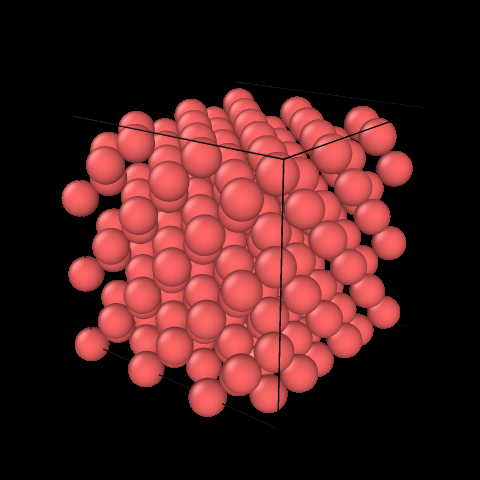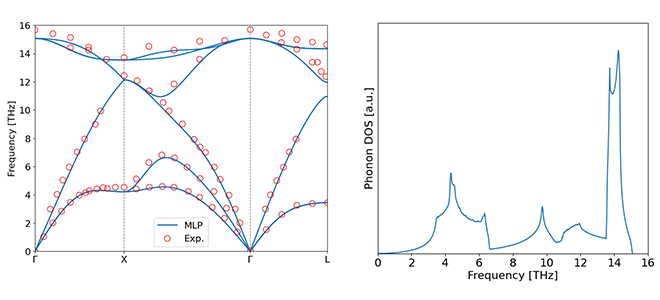Lattice thermal conductivity calculation using machine learning potential
- Phonon analysis-based thermal conductivity evaluation
- Utilization of machine learning potentials
- Analysis of frequency dependence of cumulative thermal conductivity
Silicon crystal model
The computational model used was a 3×3×3 supercell (216 atoms) of a silicon crystal. Phonon analysis was performed using a machine learning potential to estimate interatomic force constants and evaluate thermal conductivity. By calculating the phonon dispersion relation and density of states, agreement with experimental values was confirmed, demonstrating the validity of the model.

Phonon dispersion and density of states
The phonon dispersion relation showed good agreement with experimental values, and the calculated phonon density of states also confirmed validity. The comparison with experimental values of the phonon dispersion relation is shown on the left, and the calculated phonon density of states is shown on the right, demonstrating high accuracy and reliability of the analysis. It was shown that phonon analysis using a machine learning potential is effective.

Thermal conductivity and cumulative contributions
The temperature dependence of thermal conductivity and the cumulative thermal conductivity as a function of mean free path and phonon frequency are shown. The left panel compares thermal conductivity with experimental values, the middle panel shows cumulative thermal conductivity with respect to mean free path, and the right panel shows cumulative thermal conductivity with respect to phonon frequency. These analyses reveal that low-frequency phonons contribute significantly to heat transport.

[2] Batatia, I., Kovacs, D. P., Simm, G. N. C., Ortner, C., & Csanyi, G. (2022, October 31). MACE: Higher order equivariant message passing neural networks for fast and accurate force fields. OpenReview.
[3] Bartók, A. P., Payne, M. C., Kondor, R., & Csányi, G. (2010). Gaussian Approximation Potentials: The Accuracy of Quantum Mechanics, without the Electrons. Physical Review Letters, 104(13).
[4] Kulda, J., Strauch, D., Pavone, P., & Ishii, Y. (1994). Inelastic-neutron-scattering study of phonon eigenvectors and frequencies in Si. Physical Review. B, Condensed Matter, 50(18), 13347-13354.
[5] Inyushkin, A. V., Taldenkov, A. N., Gibin, A. M., Gusev, A. V., & Pohl, H. (2004). On the isotope effect in thermal conductivity of silicon. Physica Status Solidi. C, Conferences and Critical Reviews/Physica Status Solidi. C, Current Topics in Solid State Physics, 1(11), 2995-2998.AA5





